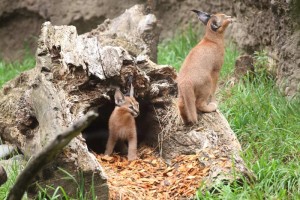| One of the kittens making its way in learning about logs. |
Caracals have distinctive features, with large pointed ears that have tufts of black fur. Their ears are large to help them locate prey. But like most felines, caracal kittens are born with their eyes closed and their ears folded down. The babies and the mom were both kept out of public view for a while, allowing the kittens to grow bigger without the stress of the public's presence. The public could still see the cubs' father, Cricket, who remained available to the public.
According to senior Africa keeper, Laura Weiner, "Peggy has been a terrific mom. She's very protective. We put a bunch of straw in her den box as bedding, and she's been covering the little ones up with it, hiding them. Wild cats of all species hide their kittens like that to protect them from predators."
By now the caracal kittens have done some growing. They are six weeks old and weigh two to three pounds, just a bit bigger than domestic cats of the same age. But their paws and ears are much bigger, and prepare them for their lives as predators. Now, both cubs have names - Nandi for the boy and Nisha for the girl.
Now that they are larger, both kittens have been introduced to their outdoor habitat, accompanied by mother Peggy. However, they are only there part time, 10 AM to 2 PM daily. According to lead Caracal Keeper, Beth Foster, "They've spent a lot of time out of view of visitors so far. The space is still new and unfamiliar to them, so they've been hiding a lot, taking things slowly, and sticking close to mom." This is actually normal behavior for caracals in the wild, since hiding gives them the element of surprise when they're hunting prey.
Even so, both Nandi and Nisha are getting in some exploration time in their new area, finding out how to get into hollow logs, hiding in tall grass, finding out that claws don't grip very well on rocks, and chirping for mom when they can't find her. Ms. Foster continues, "Peggy's been an excellent and very attentive mom. When her little ones call, she comes right away to check on them."
 |
| The caracal babies enjoying a rock hollow. |
| Newborn caracals have closed eyes, just like domestic kittens. |
Click here: SECRETS OF FREEMASONS ULTIMATE COMPENDIUM


No comments:
Post a Comment